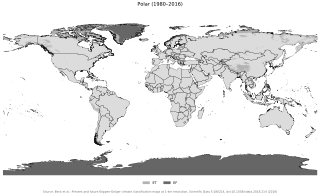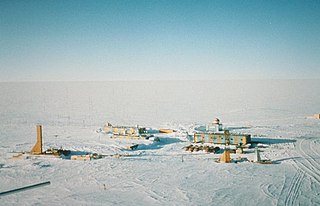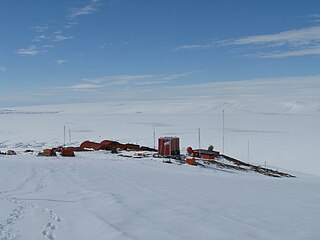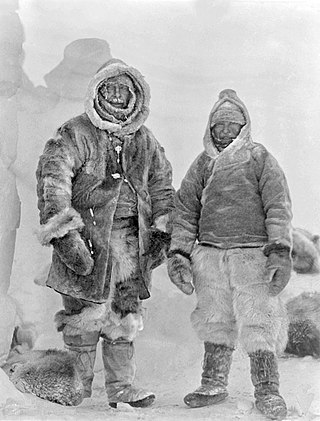
Greenland is located between the Arctic Ocean and the North Atlantic Ocean, northeast of Canada and northwest of Iceland. The territory comprises the island of Greenland—the largest island in the world—and more than a hundred other smaller islands. Greenland has a 1.2 kilometre long border with Canada on Hans Island. A sparse population is confined to small settlements along certain sectors of the coast. Greenland possesses the world's second-largest ice sheet.

The polar climate regions are characterized by a lack of warm summers but with varying winters. Every month a polar climate has an average temperature of less than 0 °C (32 °F). Regions with a polar climate cover more than 20% of the Earth's area. Most of these regions are far from the equator and near the poles, and in this case, winter days are extremely short and summer days are extremely long. A polar climate consists of cool summers and very cold winters, which results in treeless tundra, glaciers, or a permanent or semi-permanent layer of ice. It is identified with the letter E in the Köppen climate classification.

The climate of Antarctica is the coldest on Earth. The continent is also extremely dry, averaging 166 mm (6.5 in) of precipitation per year. Snow rarely melts on most parts of the continent, and, after being compressed, becomes the glacier ice that makes up the ice sheet. Weather fronts rarely penetrate far into the continent, because of the katabatic winds. Most of Antarctica has an ice-cap climate with extremely cold and dry weather.

Vostok Station is a Russian research station in inland Princess Elizabeth Land, Antarctica. Founded by the Soviet Union in 1957, the station lies at the southern Pole of Cold, with the lowest reliably measured natural temperature on Earth of −89.2 °C. Research includes ice core drilling and magnetometry. Vostok was named after Vostok, the lead ship of the First Russian Antarctic Expedition captained by Fabian von Bellingshausen. The Bellingshausen Station was named after this captain.

An ice core is a core sample that is typically removed from an ice sheet or a high mountain glacier. Since the ice forms from the incremental buildup of annual layers of snow, lower layers are older than upper ones, and an ice core contains ice formed over a range of years. Cores are drilled with hand augers or powered drills; they can reach depths of over two miles (3.2 km), and contain ice up to 800,000 years old.

Oymyakon is a rural locality in Oymyakonsky District of the Sakha Republic, Russia, located in the Yana-Oymyakon Highlands, along the Indigirka River, 30 km (19 mi) northwest of Tomtor on the Kolyma Highway. Oymyakon is the coldest permanently inhabited human settlement on Earth, with an average winter temperature of around −50 °C (−58 °F).

Alfred Lothar Wegener was a German climatologist, geologist, geophysicist, meteorologist, and polar researcher.
North Ice was a research station of the British North Greenland Expedition on the inland ice of Greenland. The coordinates of the station were 78°04′N38°29′W, at an altitude of 2,341 metres (7,680 ft) above sea level. The British North Greenland Expedition had its main base camp in Britannia Lake, Queen Louise Land. It was led by Commander James Simpson RN. The station recorded a temperature of −66.1 °C (−87.0 °F) on 9 January 1954, which made it the lowest temperature ever recorded in North America up until that time. It was superseded by an observation of −69.6 °C (−93.3 °F) at the Greenland Ice Sheet on 22 December 1991. The name of the station contrasts to the former British South Ice station in Antarctica.

Belgrano II Base is a permanent, all year-round Argentine Antarctic base and scientific research station named after General Manuel Belgrano, one of the Libertadores and the creator of the Argentine Flag. It is located on Bertrab Nunatak on the Confín Coast, Coats Land.
The 1936 North American cold wave ranks among the most intense cold waves in the recorded history of North America. The Midwestern United States and the Canadian Prairies were hit the hardest. Only the Southwestern United States and California largely escaped its effects.

The climate of the Arctic is characterized by long, cold winters and short, cool summers. There is a large amount of variability in climate across the Arctic, but all regions experience extremes of solar radiation in both summer and winter. Some parts of the Arctic are covered by ice year-round, and nearly all parts of the Arctic experience long periods with some form of ice on the surface.

Plateau Station is an inactive American research and South Pole—Queen Maud Land Traverse support base on the central Antarctic Plateau. Construction on the site started on December 13, 1965, and the first traverse team arrived in early 1966. The base was in continuous use until January 29, 1969, when it was closed but mothballed for future use, and was the most remote and coldest of any United States stations on the continent. It was also the site for the world's coldest measured average temperature for a month at that time, recorded in July 1968, at −99.8 °F (−73.2 °C).

Greenland's climate is a tundra climate on and near the coasts and an ice cap climate in inland areas. It typically has short, cool summers and long, moderately cold winters.

Summit Camp, also known as Summit Station, is a year-round staffed research station near the apex of the Greenland ice sheet. The station is located at 3,216 metres (10,551 ft) above sea level.

The British Arctic Air Route Expedition (BAARE) was a privately funded expedition to the east coast and interior of the island of Greenland from 1930 to 1931. Led by Gino Watkins, it aimed to improve maps and charts of poorly surveyed sections of Greenland's coastline, and to gather climate data from the coast and interior during the north polar winter. This venture was followed by the smaller 1932–1933 East Greenland expedition, led by Watkins until his death.

The Trewartha climate classification (TCC) or the Köppen–Trewartha climate classification (KTC) is a climate classification system first published by American geographer Glenn Thomas Trewartha in 1966. It is a modified version of the Köppen–Geiger system, created to answer some of its deficiencies. The Trewartha system attempts to redefine the middle latitudes to be closer to vegetation zoning and genetic climate systems.

Hovgaard Island is a large uninhabited island of the Greenland Sea, Greenland. The island was named after Andreas Hovgaard, a Polar explorer and officer of the Danish Navy who led an expedition to the Kara Sea on steamship Dijmphna in 1882–83.

Fritz Loewe was a German polar explorer, glaciologist, geophysicist and meteorologist.

The Danish Expedition to Queen Louise Land, also known as the Danish expedition to Queen Louise Land and straight through Greenland’s ice sheet, as well as Danish North Greenland Expedition, was an expedition to northeastern Greenland and across the Greenland ice sheet in 1912–1913. It was the first such venture that went across the broad central part of Greenland. The expedition was led by Johan Peter Koch (1870–1928). The purpose of the venture was to study the vast ice sheet, making glaciological and meteorological observations. Instead of sled dogs, sixteen Icelandic ponies were chosen for transporting 20 tons of materials, including 6 t of compressed hay to feed the ponies.

The German Greenland Expedition, also known as the Wegener Expedition, was an expedition to Greenland in 1930–1931. It was led by German scientist Alfred Wegener (1880–1930), who had previously taken part in two other ventures to Greenland. His purpose was to make a systematic study of the Greenland ice sheet.





















